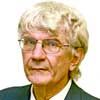Of Hebe Pastor de Bonafini, who died last weekend just a fortnight shy of turning 94, it might be said that she always did the right thing during dictatorship and always said the wrong thing during democracy – somewhat of a simplification as all such sweeping statements invariably are but not overmuch.
“De mortuis nihil nisi bonum (“of the dead speak nothing but good”),” we have been advised since Roman times – even if the eulogy of perhaps the most famous Latin-speaker of them all (Julius Caesar) might seem to contradict that: “The evil that men do lives after them; the good is oft interred with their bones” (Shakespeare dixit). So this columnist will conscientiously set out to speak nothing but good of Hebe de Bonafini and see if that fills the space.
Bonafini’s image is inseparable from her white headscarf, which immediately takes us to her main claim to fame, her leadership of the Madres de Plaza de Mayo (“Mothers of Plaza de Mayo”), which she co-founded in 1977 with Azucena VillafIor (who went missing at the end of that year with her remains finally identified in 2005). The combination of the latter’s martyrdom and Bonafini’s increasingly abrasive political and social commentary riling middle-class opinion has led to her seminal role in the creation of the Mothers losing recognition in many circles.
But while not one of the 13 women making that original march around Plaza de Mayo on April 30, 1977 (literally complying with a policeman’s order to “circulate”), her older son Jorge had already disappeared two months previously and she was among the hundreds soon joining the snowballing movement, which she turned into an organisation, heading it as from 1979. She certainly paid her dues in terms of human suffering during the 1976-1983 dictatorship, losing both her sons, her daughter-in-law and her husband Humberto Bonafini (1925-1982) in the course of those years.
Speaking good of Hebe de Bonafini also implies clarifying her role in the Misión Sueños Compartidos (Shared Dreams) housing scam while not clearing her name altogether. Launched in 2006 to build low-cost housing for the underprivileged with a total budget of 1.3 billion pesos pledged by the state, the scandal broke in 2011 when it was ascertained that 206 million of the 749 million pesos of funds advanced until then had vanished. Both Bonafini and Fundación Madres de Plaza de Mayo trustee Sergio Schoklender went to trial in 2017. Yet one only need see Bonafini’s humble La Plata home to understand that whatever her faults, they do not include corruption (unlike so many Kirchnerites) – the missing millions should be laid at the door of Schoklender, who openly boasted on television of his Ferrari and Porsche. Nevertheless, the shockingly poor judgement of entrusting a multi-million fund to a convicted parricide like Schoklender demands an explanation, as does the then government so insanely mixing apples and oranges in allocating housing starts to a human rights organisation.
That poor judgement might find some justification in her early biography – born in 1928 in the La Plata port district of Ensenada into a family so poor that they could not afford the bus tickets even for her to complete her primary school education, she was married at the absurdly early age of 14. The next 35 years of her life seem to have been absorbed in bringing up her three children.
The traumas of 1977, when she lost both her sons, were the turning-point in her life, taking her from complete obscurity to a place in Argentine history and even the world spotlight. Deserved fame for her resistance to dictatorship but when Argentina returned to democracy, she persisted in the opposite direction, remaining in the spotlight but with an increasingly controversial image.
Perhaps that year now so much in vogue with the film Argentina, 1985 can be taken as a second turning-point. Hard not to see the juntas trial depicted in that film and the CONADEP truth commission providing it with its material (groundwork given insufficient mention by the film) as supreme affirmations of human rights but somehow Bonafini did – rejecting the CONADEP report as enshrining the “two demons” theory in recognising a terrorist prelude to military repression, while scorning the juntas trial as “bourgeois justice.” This crass repudiation of human rights milestones was incomprehensible to many Mothers and in 1986 she was obliged to secede from the mainstream organisation to form her own Madres de Plaza de Mayo-Línea Fundadora (“Mothers of Plaza de Mayo–Founding Line). Hostile to both the Radical administration of Raúl Alfonsín and the following presidency of the neo-conservative Peronist Carlos Menem, her story in this century was increasingly co-optation by Kirchnerism.
“Nihil nisi bonum” notwithstanding, no obituary of Bonafini would be complete without her constant stream of controversial stances but space as much as respect for the dead obliges this to be minimised. By far the most egregious was her celebration of the 9/11 attack, which she described as “the act of very valiant men and women” and a just revenge on the United States “for training our military to torture our people” as well as for millions of children dying of hunger worldwide. This should speak for itself – no need to enter into the details of her constant tirades against her pet targets of the Judiciary, the press and the Church (until her reconciliation with Pope Francis in 2016). After the three days of national mourning, may she rest in peace.



















Comments